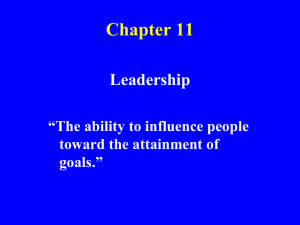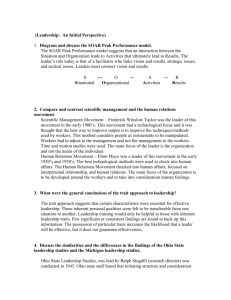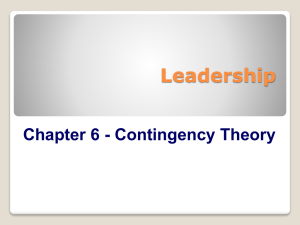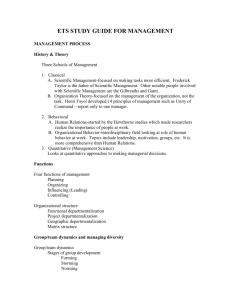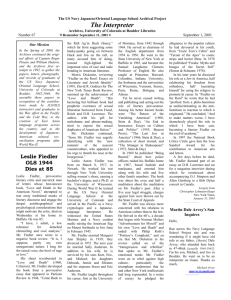Running Head: FIEDlER'S SITUATIONAL LEADERSHIP THEORY 1
advertisement
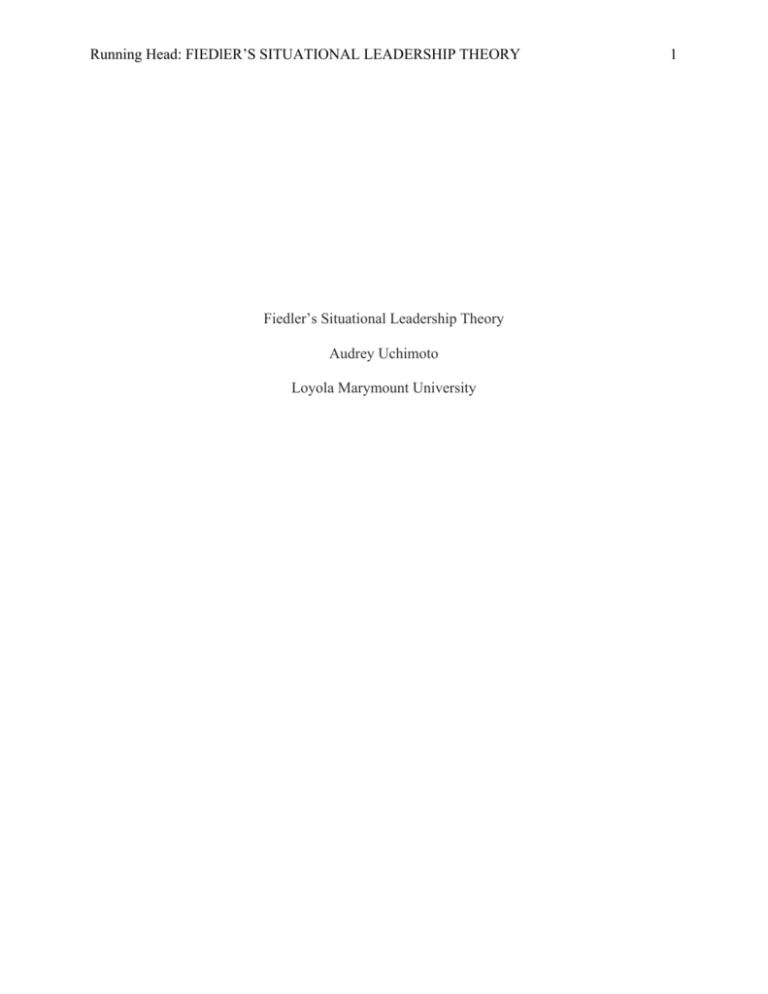
Running Head: FIEDlER’S SITUATIONAL LEADERSHIP THEORY Fiedler’s Situational Leadership Theory Audrey Uchimoto Loyola Marymount University 1 FIEDlER’S SITUATIONAL LEADERSHIP THEORY 2 Abstract Situational leadership theory is the belief that there is no one best style of leadership. A leader’s style should always change to meet different circumstances. Psychologist Fred Fiedler explains the different types of leadership styles and circumstances they work best with. Fiedler first explains different types of leaderships and then later towards the end of my essay, separates leaders’ personalities into two categories, task-oriented and relationship-oriented. My essay explains how each of these personality traits work differently in a given situation and when which is most effective. My essay also explains three critical, situational components that are likely to affect the leader’s influence and outcome of a task. Lastly, my essay explains Fiedler’s Contingency Theory, which summarizes his findings on situational leadership. The information I found to research this topic, which is cited at the end of my essay, is from Google Scholars and Loyola Marymount's databases. Keywords: Fiedler, Situational Leadership Theory, Contingency Theory FIEDlER’S SITUATIONAL LEADERSHIP THEORY 3 Situational leadership is the belief that there is no single best style of leadership. Effective leadership is task-relevant, and the most successful leaders are those who can adapt their leadership style to the specific group they are attempting to lead. Effective leadership varies, not only with the group that is being influenced, but also with the task that needs to be accomplished and the surrounding circumstances. Psychologist Fred Fiedler is an avid believer in situational leadership and formed his own situational leadership theory. Fiedler believes that there is no universal leadership style or characteristics and that different types or styles will be more effective in different situations. According to Leonard Berkowitz (1964) Fiedler’s leadership research has primarily been concerned with what personality traits or attributes determine whether a leader will become effective? Fiedler labeled different clusters of groups and studied which type of personalities and leadership styles worked best in different scenarios. The clusters Fiedler created were labeled “autocratic vs. democratic; authoritarian vs. equalitarian; task-oriented vs. human-relationsoriented; self-oriented vs. group-oriented; psychologically close, permissive vs. distant, controlling, managing; or ‘initiation of structure’ vs. ‘consideration’”(Berkowitz 150). The personalities and behaviors of each of these clusters are different and they all proved to play a crucial part in affecting group performances differently. Fiedler found that autocratic leadership seems to promote greater quantitative productivity, while democratic leadership tends to result in higher morale and qualitative productivity. Autocratic leaders, therefore, appear to be most effective in “industrial work situations or the armed forces, in which the task requires strong, centralized control” (Berkowitz 155). A number of studies have shown that human-relations-oriented supervisory attitudes tend to promote increased morale and productivity in a work situation found that foremen of highly FIEDlER’S SITUATIONAL LEADERSHIP THEORY 4 productive work groups were more democratic and non-punitive in their supervisory behavior than foremen of low-producing groups. Although democratic supervision itself was not related to productivity it showed that the personal interest of supervisors in their subordinates was positively related to effectiveness of management; and that democratically led organizations function more effectively and creatively. Fiedler also found that groups with an active discussion leader are more effective on a problem-solving task than they were with permissive, passive, observing leaders. “There is a positive correlation between rated efficiency of the air crew and the aircraft commander’s tendency to manifest friendly, mutually trusting relations defined by the term ‘consideration’” (Berkowitz). Studies have indicated that the power of leadership position plays an important role in determining the type of leadership attitude and behavior which will contribute to group effectiveness. A leader who has a powerful position will behave differently from one who holds a very tenuous position. The findings in this field made it clear that different group situations require different leadership styles. Progress in predicting group effectiveness seemed to require a meaningful system for classifying groups in terms of relevant situational factors. According to Liz Lee-Kelley (2003), leadership is generally thought of as an interpersonal situation in which one individual in the group has influence over others for the purpose of performing an assigned task. It will, therefore, be very important to know whether the group environment will make it relatively easy or difficult for the leader to influence the members of his group. A “good” system of classification would then be based on the crucial factors which determine whether a given situation is favorable or unfavorable for the leader. FIEDlER’S SITUATIONAL LEADERSHIP THEORY 5 Fiedler stated that there are three critical situational components which are likely to affect the leader’s influence. These components are the leader’s personal relations with members of his group, the power and authority which the leader position provides, and the degree of structure in the task which the group has been assigned to perform. In order for a leader and group to have an affective leader-group relationship, the personal relationship between the leader and key members of his group is the most important, single determinant of group processes which affect team performance. The liked and respected leader does not need formal power and can obtain compliance from the group under circumstances which, in the case of a disliked or distrusted leader, would result in open revolt. As has been shown, the liked and accepted leader’s interpersonal attitudes influence group performance to a significantly greater degree than similar attitudes of a leader who is not accepted or respected by his group. The leader who feels accepted by his group members is able to act more decisively and with more confidence than the leader who feels rejected or distrusted by the members of his group. The second component of importance Fiedler explains is the task structure which describes the nature of the task in terms of its clarity or ambiguity. The leader’s job will be considerably easier if the job is highly structured than if it is vague and unspecific. The third component Fiedler calls is position power. Position power is defined by the power inherent in the leadership position. This power includes the rewards that the leader has authority to give over group members. This ability of the leader gives him more power. According to Fiedler in his research on Leadership Selection and Training: One View of the Future (1996), personalities and leadership styles can either be task-oriented or relationshiporiented. Depending on the task one of these leadership styles will be best suited for the FIEDlER’S SITUATIONAL LEADERSHIP THEORY 6 situation. Based off of this belief, Fiedler created the Contingency Theory which is today known as Fiedler’s Contingency Theory. According to Julia Wood’s article, Alternate Portraits of Leaders: A Contingency Approach to Perceptions of Leadership (1979), Fiedler’s Contingency Theory shows the relationship between the leader’s orientation or style and group performance under differing situational conditions. The theory is based on determining the orientation of the leader, whether relationship or task, the elements of the situation, leader-member relations, task structure, and leader position power, and the leader orientation that was found to be most effective as the situation changed from low to moderate to high control. The Fiedler’s Contingency Theory claims that relationship oriented people are more concerned with personal relations, more sensitive to the feelings of others, and better off at heading off conflict. They use their good relations with the group to get the job done. They are better able to deal with the complex issues in making decisions. In high control situations, relationship oriented people tend to become bored and are no longer challenged. They may seek approval from their superiors by ignoring their subordinates, or they may try to reorganize the task. As a result, they often become inconsiderate toward their subordinates, more punishing, and more concerned with performance of the task. In moderate control situations, they focus on group relations. They reduce the anxiety and tension of group members, and thus reduce conflict. They handle creative decision making groups well. They see this situation as challenging and interesting and perform well in it. In low control situations, they become absorbed in obtaining group support often at the expense of the task. Under extremely stressful situations, they may also withdraw from the leadership role, failing to direct the group’s work. FIEDlER’S SITUATIONAL LEADERSHIP THEORY 7 Task oriented leaders on the other hand are generally more concerned with the task, and less dependent on group support. They tend to be eager and impatient to get on with the work. Task oriented leaders quickly organize the job and have a no-nonsense attitude about getting the work done. In moderate control situations, they tend to be anxious and less effective. This situation is often characterized by group conflict. They become absorbed in the task and pay little attention to personal relations in the group. They tend to be insensitive to the feelings of their group members, and the group resents the lack of concern. In high control situations, task oriented leaders tend to relax and to develop pleasant relations with subordinates. They are easy to get along with. As the work gets done, they do not interfere with the group or expect interference from their superiors. In low control situations, they devote themselves to their challenging tasks and they organize and drive the group to task completion. They also tend to control the group tightly and maintain strict discipline. Group members often respect their task oriented leader. Fiedler explains the different aspects of situational leadership and how different characteristics reveal different effectiveness. There will never be one single best style of leadership, but with an understanding of Fiedler’s Situational Leadership Theory, one can continuously make effective decisions in choosing the best leadership style for each new task, depending on the circumstances given. FIEDlER’S SITUATIONAL LEADERSHIP THEORY References Berkowitz, L. (1964). A Contingency Model of Leadership Effectiveness. Advances in Experimental Social Psychology, Volume 1 (pp. 150-167). Fiedler, F. E. (1996, June). Research on Leadership Selection and Training: One View of the Future. Administrative Science Quarterly , 41(2), 241-250. Retrieved from http://www.jstor.org/stable/2393716 Lee-Kelley, L. (2003, November). Turner's five-functions of project-based management and situational leadership in IT services projects. International Journal of Project Management , 21(8), 583-591. Retrieved from http://www.sciencedirect.com/science/article/pii/S026378630200100X Wood, J. T. (1979). Alternate Portraits of Leaders: A Contingency Approach to Perceptions of Leadership. The Western Journal of Speech Communication, 260-270. Abstract retrieved from http://0-ehis.ebscohost.com.linus.lmu.edu/ ehost/pdfviewer/pdfviewer?sid=c1da1b66-3c89-4237-89fb ef684033b0f7%40sessionmgr11&vid=13&hid=22 8
